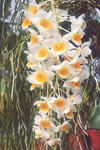
 |
 |
|
Most Common Orchids
Other Links
|
| Home | | | Anguloa | | | Cattleya | | | Cymbidium | | | Oncidium | | | Epidendrum | | | Catasetum | | | Miltonia | | |
|
Dendrobium
Dendrobium is one of the largest of all orchid groups. There are about 1,200 individual species. All Dendrobiums are epiphytes. Some are deciduous and hold onto their leaves all year round. Growers usually divide Dendrobium into groups based on their growing conditions.
Water : Dendrobium prefers high humidity and lots of water during growing conditions of the plant, but at least weekly is best during summer. After growing season, cut water back somewhat but not suspend watering.
Fertilizer : We can fertilize with balanced fertilizer like peters 20-20-20 at quarter strength with every watering. After the end of growing season, we must reduce fertilizer by half to help provoke better bloom. We must feed heavily during growing season with weak fertilizer solution containing lots of nitrogen.
Temperature : The temperature for the plant should be above 60 degree at all times, but it can withstand few nights down to 50. But it is better to avoid. As light drop in night time temp. will stimulate a bloom.
Light : The plant likes strong, natural sunlight. It will grow in lower light conditions, but it is unlikely the plant will bloom well. The appearance of tiny plantlets on older canes often means plant isn't getting enough light.
Blooming : To help provoke a flower spike, slightly drop the water and nighttime temperature. If cane loses all it's leaves don't cut it off because it sometime bloom from old canes. Flowers are usually long lasting up to six weeks.
Potting and Repotting : These are epiphytic orchid that thrive in hanging baskets with little or no potting media. The plants are often top heavy and the wood gradually rots away. Repotting must be done at the beginning of the growing season when necessary.
